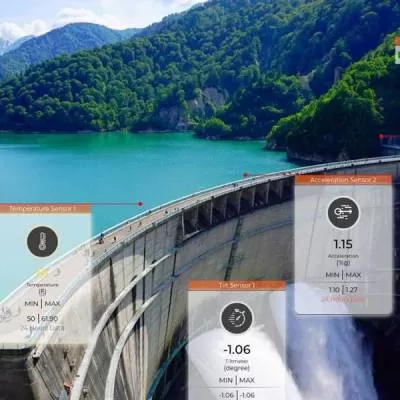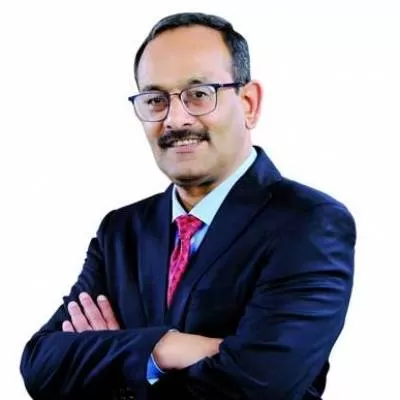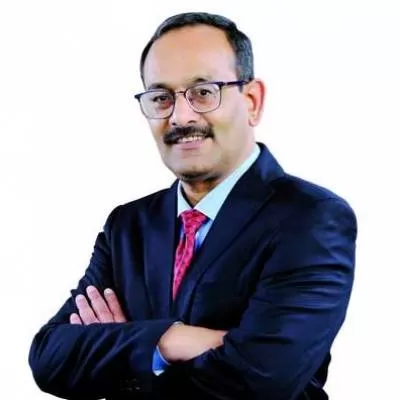- Home
- Technology
- Global Tech for Local Needs
Global Tech for Local Needs
Today, people spend 80-90 per cent of their lives in buildings, making buildings an integral part of their ecosystem. With the advent of new technologies, the role buildings play is being redefined from a static environment to a more dynamic and interactive space that has an impact on the lifestyles, well-being, and productivity of occupants. In effect, smart buildings are a fundamental building block for a smarter city.
Honeywell solutions
Globally, we are present in homes, industries and buildings with intelligent products delivering safety, productivity and performance:
Presence in 150 million homes globally as an industry leader with over 15 million systems installed annually, and a massive installed base of over 10 million buildings equipped with smart devices.
Differentiating with a complete portfolio comprising wireless, voice, mobility, data analytics, edge devices, software and ecosystem partners to drive connected buildings.
Selling nine times more thermostats and two-and-a-half times more security systems than the nearest competitors.
Honeywell solutions are already present across verticals in India´s largest mission critical facilities, government infrastructure, airports, stadia, metro stations, IT and hospitality. Our products and solution are at work in 150 million homes, 10 million buildings, and hundreds of gas and electric utilities worldwide, giving customers the ability to capture more and better data, faster, and across a wireless landscape, improve productivity, safety, and security, drive better decision-making, and reduce costs. Over 50 per cent of Honeywell´s portfolio is linked to energy-efficiency and can help buildings cut their energy consumption by up to 25 per cent.
The India angle
Here are some examples of work Honeywell has done in India to make buildings smarter:
Honeywell's building management systems (BMS) are at work in Delhi airport, enhancing safety, security and comfort for over 36 million passengers each year, and in Kolkata airport for over 10 million passengers each year.
The company is making travel safer, more secure, more reliable and comfortable for over 2 million Delhi Metro passengers every day.
Its integrated process solutions are at work to make the world´s largest refinery complex at Jamnagar safer, more secure and reliable.
Honeywell technologies combine building, security, energy, and life-safety systems to transform the experience of 45,000 spectators at Wankhede Stadium in Mumbai.
The company has deployed its first city surveillance project in Bhubaneswar, Odisha, one of India´s first three proposed smart cities. On February 5, 2015, Odisha´s city surveillance was inaugurated by Chief Minister Naveen Patnaik, who stated, ´This surveillance system is one-of-its-kind in the entire state, and has been successful in bringing about collaboration of the best tools of technology to aid day-to-day policing.´ It is among the few successful and on-time deliveries of such scale in a non-metro city of India. The surveillance system includes integrated CCTV, automatic number plate reading cameras (ANPR) and a command-and-control centre operated out of the police commissioner´s office. It has advanced video analytics to alert the police about traffic violations and abandoned objects supported by 113 fixed IP and PTZ Honeywell cameras on a Honeywell DVM platform along with 99 PCR vans on Honeywell cameras and mobile DVR.
Kerala's 50,000-spectator capacity multipurpose stadium has selected Honeywell public address and voice evacuation systems.
Honeywell and Tata Power Delhi Distribution Ltd (TPDDL) successfully implemented the first-ever automated demand response (ADR) project for commercial and industrial facilities in India. TPDDL will use Honeywell technology and services to link over 160 buildings in its distribution network, and call for temporary reductions in energy use when demand threatens to outpace supply in grid stress conditions.
The company has recently launched the Command and Control Suite, which makes a building better and smarter. This turns complex facility data into recommendations and easy-to-implement changes that help boost business outcomes lowering costs, minimising risk and reducing downtime. By combining intelligent automation, advanced analytics and visualisation with the simplified user experience of today´s home and mobile electronics, the Command and Control Suite links building automation and the enterprise. It can provide a holistic view of a connected building´s video feeds, access control and fire alarms, for example, and pull in relevant information from human resource applications. Integrating data from these disparate systems could help security personnel track occupants and ensure that they exit the facility in the event of an evacuation, improving employee safety. ´Investing in this type of smart building technology typically pays for itself within one or two years by delivering operational efficiencies as well as energy savings,´ according to a recent report by financial and professional services firm Jones Lang LaSalle.
Raising awareness
Setting up smart buildings and building smart cities require the support, commitment and involvement of a variety of public and private stakeholders like developers, owners, operators and users. The key challenges are lack of awareness and policies to incentivise smart building stakeholders. There is a continuous need for training and educating stakeholders about technology innovation in this space.
Honeywell has developed a comprehensive global
Honeywell Smart Building Score, applying rigorous research and ground-up market intelligence. We have shared research outcomes and launched the Honeywell Smart Building Score for wider use across Indian industry during the global launch, from India, on June 23, 2015, in the presence of senior representatives from the US Embassy and USIBC, government, industry, think-tanks, and media, along with Alex Ismail, President & CEO, Automation and Control Solutions, Honeywell, and the Honeywell India leadership team. Honeywell has been increasingly gaining a mindshare and thought leadership position in the smart buildings space. Each city is unique. Its smartness is determined by how technology could facilitate smartness, yet preserve the soul of the city. The success of a smart building and smart city is determined by how the needs of city stakeholders (developers, citizens, government, and others) are used to develop the city and how the accountability-responsibility matrix is clearly laid out for execution.
About the author:
Priyanshu Singh, Country Manager, Honeywell Building Solutions, India, is responsible for strategically leading and driving profitability and growth for the HBS business in India. Before joining Honeywell, he spent nearly five years as Consultant with McKinsey & Company, UK and India.
Use technology to get smarter while preserving the soul of the city, urges PRIYANSHU SINGH. Today, people spend 80-90 per cent of their lives in buildings, making buildings an integral part of their ecosystem. With the advent of new technologies, the role buildings play is being redefined from a static environment to a more dynamic and interactive space that has an impact on the lifestyles, well-being, and productivity of occupants. In effect, smart buildings are a fundamental building block for a smarter city. Honeywell solutions Globally, we are present in homes, industries and buildings with intelligent products delivering safety, productivity and performance: Presence in 150 million homes globally as an industry leader with over 15 million systems installed annually, and a massive installed base of over 10 million buildings equipped with smart devices. Differentiating with a complete portfolio comprising wireless, voice, mobility, data analytics, edge devices, software and ecosystem partners to drive connected buildings. Selling nine times more thermostats and two-and-a-half times more security systems than the nearest competitors. Honeywell solutions are already present across verticals in India´s largest mission critical facilities, government infrastructure, airports, stadia, metro stations, IT and hospitality. Our products and solution are at work in 150 million homes, 10 million buildings, and hundreds of gas and electric utilities worldwide, giving customers the ability to capture more and better data, faster, and across a wireless landscape, improve productivity, safety, and security, drive better decision-making, and reduce costs. Over 50 per cent of Honeywell´s portfolio is linked to energy-efficiency and can help buildings cut their energy consumption by up to 25 per cent. The India angle Here are some examples of work Honeywell has done in India to make buildings smarter: Honeywell's building management systems (BMS) are at work in Delhi airport, enhancing safety, security and comfort for over 36 million passengers each year, and in Kolkata airport for over 10 million passengers each year. The company is making travel safer, more secure, more reliable and comfortable for over 2 million Delhi Metro passengers every day. Its integrated process solutions are at work to make the world´s largest refinery complex at Jamnagar safer, more secure and reliable. Honeywell technologies combine building, security, energy, and life-safety systems to transform the experience of 45,000 spectators at Wankhede Stadium in Mumbai. The company has deployed its first city surveillance project in Bhubaneswar, Odisha, one of India´s first three proposed smart cities. On February 5, 2015, Odisha´s city surveillance was inaugurated by Chief Minister Naveen Patnaik, who stated, ´This surveillance system is one-of-its-kind in the entire state, and has been successful in bringing about collaboration of the best tools of technology to aid day-to-day policing.´ It is among the few successful and on-time deliveries of such scale in a non-metro city of India. The surveillance system includes integrated CCTV, automatic number plate reading cameras (ANPR) and a command-and-control centre operated out of the police commissioner´s office. It has advanced video analytics to alert the police about traffic violations and abandoned objects supported by 113 fixed IP and PTZ Honeywell cameras on a Honeywell DVM platform along with 99 PCR vans on Honeywell cameras and mobile DVR. Kerala's 50,000-spectator capacity multipurpose stadium has selected Honeywell public address and voice evacuation systems. Honeywell and Tata Power Delhi Distribution Ltd (TPDDL) successfully implemented the first-ever automated demand response (ADR) project for commercial and industrial facilities in India. TPDDL will use Honeywell technology and services to link over 160 buildings in its distribution network, and call for temporary reductions in energy use when demand threatens to outpace supply in grid stress conditions. The company has recently launched the Command and Control Suite, which makes a building better and smarter. This turns complex facility data into recommendations and easy-to-implement changes that help boost business outcomes lowering costs, minimising risk and reducing downtime. By combining intelligent automation, advanced analytics and visualisation with the simplified user experience of today´s home and mobile electronics, the Command and Control Suite links building automation and the enterprise. It can provide a holistic view of a connected building´s video feeds, access control and fire alarms, for example, and pull in relevant information from human resource applications. Integrating data from these disparate systems could help security personnel track occupants and ensure that they exit the facility in the event of an evacuation, improving employee safety. ´Investing in this type of smart building technology typically pays for itself within one or two years by delivering operational efficiencies as well as energy savings,´ according to a recent report by financial and professional services firm Jones Lang LaSalle. Raising awareness Setting up smart buildings and building smart cities require the support, commitment and involvement of a variety of public and private stakeholders like developers, owners, operators and users. The key challenges are lack of awareness and policies to incentivise smart building stakeholders. There is a continuous need for training and educating stakeholders about technology innovation in this space. Honeywell has developed a comprehensive global Honeywell Smart Building Score, applying rigorous research and ground-up market intelligence. We have shared research outcomes and launched the Honeywell Smart Building Score for wider use across Indian industry during the global launch, from India, on June 23, 2015, in the presence of senior representatives from the US Embassy and USIBC, government, industry, think-tanks, and media, along with Alex Ismail, President & CEO, Automation and Control Solutions, Honeywell, and the Honeywell India leadership team. Honeywell has been increasingly gaining a mindshare and thought leadership position in the smart buildings space. Each city is unique. Its smartness is determined by how technology could facilitate smartness, yet preserve the soul of the city. The success of a smart building and smart city is determined by how the needs of city stakeholders (developers, citizens, government, and others) are used to develop the city and how the accountability-responsibility matrix is clearly laid out for execution. About the author: Priyanshu Singh, Country Manager, Honeywell Building Solutions, India, is responsible for strategically leading and driving profitability and growth for the HBS business in India. Before joining Honeywell, he spent nearly five years as Consultant with McKinsey & Company, UK and India.



















